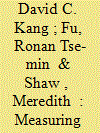| Srl | Item |
| 1 |
ID:
151284


|
|
|
|
|
| Summary/Abstract |
How much war was there in early modern East Asia? This article empirically corroborates characterizations of relations between Sinic East Asian polities as being unusually peaceful and stable, which we attribute to the participants’ shared subscription to a common and accepted hierarchy framed by a Confucian worldview. More broadly, we provide direct empirical evidence that international hierarchies derive their stability from cultural consensus rather than simply asymmetries in material power. We make these claims by addressing the extent, range, and patterns of war in early modern East Asia by introducing and describing an extensive dataset of over 1,100 entries that measures war and other violence in early modern East Asia from 1368 to 1841 and relies principally on both Chinese and Korean language sources. The combination of these two Asian language sources forms the basis of a unique dataset that will substantially widen and complement the largely Chinese or English language sources that are generally used in debating war in early modern East Asia. Asia was composed of much more than simply China, and bringing in scholarship from other areas of early modern East Asia reflects a trend of moving past national studies to research the region more holistically.
|
|
|
|
|
|
|
|
|
|
|
|
|
|
|
|
| 2 |
ID:
165259


|
|
|
|
|
| Summary/Abstract |
What does international hierarchy look like? The emerging literatures on hierarchy and international orders remain overwhelmingly focused on the contemporary era and on the great powers that comprise the top of the hierarchy. This article addresses that gap by examining diplomacy, war, and domestic politics in the premodern Vietnam–China relationship under the hierarchic tributary system. Specifically, we construct a unique data set of over 1,200 entries, which measures wars and other violence in the region from 1365 to 1789. The data revealed the stable and legitimate nature of tributary relations between formally unequal political units. The Vietnamese court explicitly recognized its unequal status in its relations with China through a number of institutions and norms. Vietnamese rulers also displayed very little military attention to their relations with China. Rather, Vietnamese leaders were clearly more concerned with quelling chronic domestic instability and managing relations with kingdoms to their south and west.
|
|
|
|
|
|
|
|
|
|
|
|
|
|
|
|